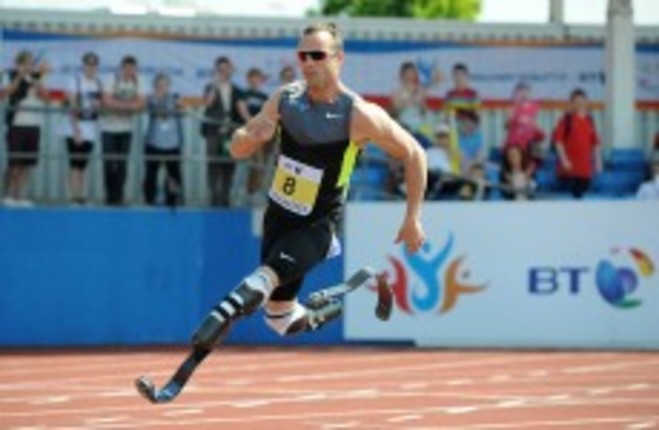IS MAN-MADE MATERIAL superior to muscle? Are those blades better than real legs?
Oscar Pistorius, the double-amputee runner, is taking the issue of disabled vs able-bodied competition into new territory as he prepares for the London Olympics.
His inclusion on South Africa’s team clears the way for him to become the first amputee runner to compete in the Olympics. And because it’s the sporting world’s biggest stage, his participation is likely to fire up the long-running debate over whether his flexible, carbon-fiber blades give him an unfair advantage.
Pistorius, 25, runs on Cheetah Flex-Foot blades, J-shaped limbs that are 16 inches (41 centimeters) long and weigh a little over a pound each.
Pistorius, whose lower legs were amputated when he was a baby after he was born without the fibula bones in his shins, has a personal best in the 400 meters of 45.07 seconds — almost two seconds off Michael Johnson’s world record — and ran a 45.20 this year, both inside the top Olympic qualifying time.
Never before has a disabled person been such a threat to the able-bodied in a sports event.
“There are tens of thousands of people with the same prosthetics I use, but there’s no one running the same times,” Pistorius wrote in a column in a British newspaper last week after he was chosen to run both the individual 400 meters and the 4×400 relay in London.
“You’ll always get people who have their opinions on whether I should be competing in London, but they can’t explain my times.”
The Blade Runner doesn’t just want to show up at the London Games, flash his photogenic smile and wave, and then retire graciously and let the top runners get on with it. Pistorius wants to be on the track among the eight finest runners in the world when the gold medal is decided on August 6.
“It’s a personal dream of his to run in the final at the Olympic Games,” Pistorius’ coach for all his career, Ampie Louw, told The Associated Press. “It’s not qualifying only.”
Pistorius told the AP: “My goals are just to be able to look back at my career and know that I didn’t let my talent go to waste. I’m just trying to prove to myself that I can be the best that I want to be.”
YouTube credit: insidenikerunning
Sports engineer David James, a senior lecturer at England’s Sheffield Hallam University, disagrees with Pistorius’ inclusion in the Olympics on both scientific and ethical grounds.
“Sport is hard-nosed and brutal and bloody and has no place for sob stories. People want Oscar to run and do well. However, will they think the same if he wins?” James said. “I predict a backlash if he wins anything. They will attribute that performance to the blades. I think there would be real implications if he won.”
Pistorius’ case was settled — legally anyway — in 2008 when sports’ highest court lifted the ban from able-bodied events imposed on him by the International Association of Athletics Federations.
The Court of Arbitration for Sport said that Pistorius probably gets some advantages from the springy, curved blades, but also suffers some disadvantages, and they even out in the end.
James doesn’t agree.
“To say he doesn’t have an advantage is stretching it,” the sports engineer said. “When he’s up to speed, he is more efficient than someone with muscle and bone. He can relocate his legs faster because they are lighter.”
Hugh Herr, an associate professor at the Massachusetts Institute of Technology and an expert in biomechanics and bionics who has conducted studies on Pistorius, agreed with the decision to reinstate Pistorius, saying there is no evidence the blades give Pistorius an edge.
Pistorius’ leg speed is quicker than that of some other athletes but not all of them, Herr said, meaning he’s “not abnormal.” And in terms of the energy he uses and the way he tires, there is, crucially, no difference, Herr said. Pistorius is probably at a disadvantage because he cannot hit the ground as hard as other athletes, the professor said.
Herr said Pistorius was forced to come up with a different running style from a young age because he had no lower legs, and developed bigger hips as a result. Those hips, and to a lesser extent his knee joints, are the key to his running, Herr said.
The view that he’s a robot that doesn’t fatigue is nonsense,” Herr said. “The science is immature. We don’t know very much, but what we do know says there’s no overall advantage for Pistorius in a 400-meter race.”
Sports ethicist and philosopher Ivo van Hilvoorde of Free University in Amsterdam said the South African athlete represents the shifting boundaries between able and disabled sport.
“We are used to thinking of disabled as less,” Van Hilvoorde said, “but it could be the other way round. Oscar Pistorius is a nice example of this.”

